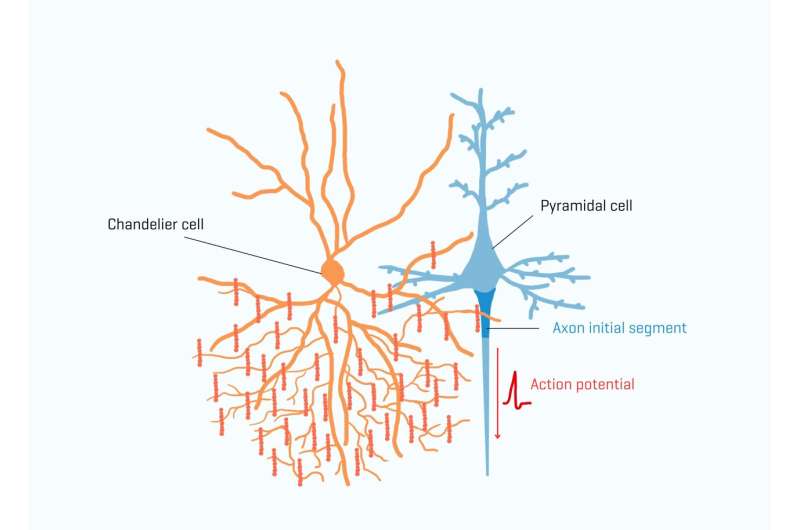This article has been reviewed according to Science X's editorial process and policies. Editors have highlighted the following attributes while ensuring the content's credibility:
fact-checked
peer-reviewed publication
trusted source
proofread
Study shows special brain cells react to unexpected situations

New research from the Netherlands Institute for Neuroscience shows that chandelier cells, a specific type of brain cell, become active during unexpected situations. Researchers have been wondering about the functionality of these cells for a long time.
Imagine you're cycling to work through the city and suddenly see a new building somewhere. On the first day that is very surprising. On day 2, this diminishes somewhat; after a week, you no longer notice it. The same thing happens the other way around: when a building that was always there suddenly disappears, you are also surprised. But how does your brain signal unexpected changes, and which cells are involved?
To learn more about this phenomenon, Koen Seignette from Christiaan Levelt's lab joined forces with his colleagues from the Kole lab and Roelfsema lab. Together, they investigated a special type of brain cell found in small numbers in the cortex: the chandelier cell. In contrast to other inhibitory brain cells, they only inhibit one spot of other cells, but little is known about why and when.
New mouse model
Koen Seignette says, "We already knew quite a lot about the function of most types of inhibitory brain cells, but chandelier cells were a mystery. This is because they are not clearly marked genetically and so could not be properly examined. We have now obtained a mouse model in which the chandelier cells are fluorescently labeled. This allows us to image them live and determine when they are active. That offers new opportunities."
"As a first step, we looked at what chandelier cells in the visual cortex respond to. What happens to these cells when the mouse starts running or when we present visual stimuli?"
"In one of the experiments, we had the mice walk in a virtual tunnel. When the mouse ran, the tunnel moved, and when it stopped, so did the tunnel. Using this setup, we could create an unexpected situation by stopping the tunnel while the mouse was still running. During these events, the chandelier cells started firing like crazy."

Plasticity
Christiaan Levelt says, "We see that the type of stimulus does not actually matter that much, what matters is that it is unexpected and surprising. We also noticed that habituation and change occur, comparable to the aforementioned example of the new building. At first, the cells react strongly, but after repeated exposure, the activity becomes weaker."
"This shows that the cells are able to adapt, which is a concept known as plasticity. This plasticity also occurs at a structural anatomical level: we can literally see changes in the synapses chandelier cells form on other brain cells."
"What makes this study important is that this is the first really comprehensive study of chandelier cells in the visual cortex. We have determined what they respond to, which brain cells they connect with, and what their influence is on other brain cells."
"This has never been looked at in such detail before. Understanding the role of these inhibitory neurons in the cortex is crucial for many processes, including learning from unexpected circumstances. We all know that you remember things better when they really surprise you. If the prediction is incorrect, that's where you can find the information. You need plasticity to update your insights, and these cells could play a role in that."
Why are chandelier cells so special?
Chandelier cells, named for their resemblance to a chandelier, are inhibitory brain cells focusing on the starting point (axon initial segment) of electrical signals in the pyramidal cells, the most common cells in the cortex.
It was thought that chandelier cells could exert strong control over pyramidal cells by blocking the action potential. Surprisingly, the current research shows that this effect is very weak, contradicting previously drawn conclusions.
The research is published in the journal eLife.
More information: Koen Seignette et al, Experience shapes chandelier cell function and structure in the visual cortex, eLife (2024). DOI: 10.7554/eLife.91153.3




















